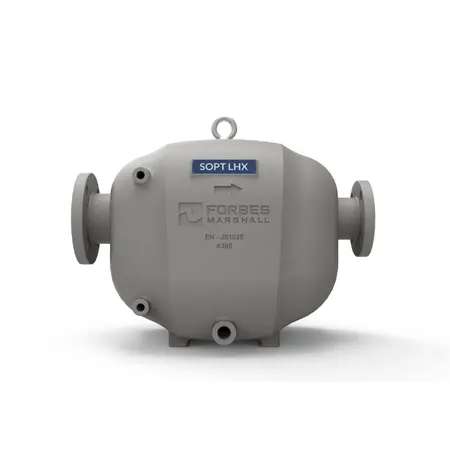Steam Operated Pump Trap SOPT
Normal float traps fail to work under vacuum/stall conditions on the process application. Under such circumstances, the steam trap is either byepassed or the the process vessel gets water-logged leading to multiple issues.
The Forbes Marshall Steam Operated Pump Trap is an innovative product which can work either in trapping or pumping modes automatically, depending on the pressure difference across the trap.
In case vacuum/stall condition arises, SOPT uses the pressure of motive steam to discharge the condensate. Under normal circumstances, it operates like any other float trap. SOPT can significantly improve productivity and product quality of processes prone to stall and vacuum conditions.
- Available as a pre-engineered, ready to comission skid mounted assembly for optimum performance.
- Also available with a two orifice mechanism for handling peak and running condensate loads (patent applied)
- Enhanced discharge capacity Robust and compact construction.
- Built-in check valve Available as skid mounted unit.
- Significant improvement in the batch time and productivity in stall/vacuum prone applications.
- Enables maintaining of temperature gradients and product quality.
- Eliminates opening of trap bypass valve during stall, resulting in steam and condensate savings Improved equipment uptime
Maintenance Schedule
Brochure
Variants
- Sizes: 40 NB X 25 NB
- Body design Conditions: PN16
- Max. Operating Pressure 14 bar g @198°C
- Max. Operating Temperature 12.8 bar g @300°C
- Sizes: 20 NB X 20 NB
- Body design Conditions PN10
- Max. Operating Pressure 4.5 bar g
- Max. Operating Temperature 155 °C @ 4.5 bar g
- Sizes 50 NB X 40 NB
- Body design Conditions PN16 /ASA CLASS 150
- Max. Operating Pressure 13.8 bar g @198°C
- Max. Operating Temperature 198°C @ 14 bar g
A full skid mounted ready to install unit with pipeline accessories and customised to process requirements.
Have a project in mind that you think we’d be a great fit for it? We’d love to know what you’re thinking
Get in Touch
Frequently Asked Questions
In steam systems, “stall” refers to a situation where steam flow is disrupted or significantly reduced. Stall conditions can occur due to due pressure imbalances, blockages, or system malfunctions.
Stall can be caused by poor trap performance, excessive air accumulation, or improperly sized components, requiring immediate attention to restore system efficiency.
The SOPT uses the pressure of motive steam to discharge condensate during vacuum or stall conditions. Unlike conventional float traps, which fail in such situations, the SOPT automatically switches between trapping and pumping modes depending on pressure differences, ensuring uninterrupted condensate removal.
Putting a non return valve at the trap outlet will only prevent the condensate from flowing back into the process and flooding it. It does not aid the condensate evacuation in stall situations. On the other hand, a steam operated pump trap uses the high pressure live steam to evacuate the condensate in stall situations.
The SOPT enhances prevents issues like waterlogging, which can slow down processes in vacuum-prone applications. It also maintains temperature gradients and product quality by effectively managing condensate.
The SOPT is available in stand-alone and skid-mounted options. The skid mounted assembly is customised to meet specific process requirements, making it a convenient and ready-to-commission solution.








